Results 1-21 of 21
<<< Previous 1 Next >>>

The Tower of William Tell at Altorf.
[Probably by Mary Anne Theresa Whitby, c.1828]
Rare lithograph. Printed area 140 x 140mm (5½ x 5½"). Foxing around edges.
The 13th century tower in the market place at Altdorf, Switzerland, where according to legend William Tell shot an apple from his son's head. In 1895 a memorial statue was erected in front of the tower. The printmaker, Mary Anne Theresa Whitby (1784-1850), was married to Captain John Whitby, flag captain for Admiral Sir William Cornwallis. They lived on the admiral's estate, Newlands: after John's death in 1806, Mary stayed on, spending much of her time with Cornwallis, who left his estate to her on his death in 1819. Being a keen amateur lithographer, Whitby established a private press at Newlands, but she is better remembered for the first successful sericulture (silk production) to England after three centuries of attempts, presenting twenty yards of damask to Queen Victoria in 1844. She performed genetic experiments on her silkworms for Charles Darwin, who published her results in his 'The Variation of Animals and Plants Under Domestication' (1868). Ex: Collection of the late Hon. C. Lennox-Boyd.
[Ref: 35713] £90.00
(£108.00 incl.VAT)
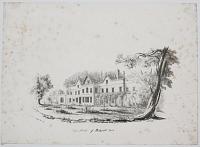
East Front of Bedwell Park.
Litho. Newlands 1829. M.A.T.W. [Mary Anne Theresa Whitby]
Lithograph, very rare; printed area approx. 200 x 315mm (8 x 12½"). Foxing around edges.
Bedwell Park in Hertfordshire, which had been owned by the brewer Samuel Whitbread in the 18th century. The printmaker, Mary Anne Theresa Whitby (1784-1850), was married to Captain John Whitby, flag captain for Admiral Sir William Cornwallis. They lived on the admiral's estate, Newlands: after John's death in 1806, Mary stayed on, spending much of her time with Cornwallis, who left his estate to her on his death in 1819. Being a keen amateur lithographer, Whitby established a private press at Newlands, but she is better remembered for the first successful sericulture (silk production) to England after three centuries of attempts, presenting twenty yards of damask to Queen Victoria in 1844. She performed genetic experiments on her silkworms for Charles Darwin, who published her results in his 'The Variation of Animals and Plants Under Domestication' (1868). Ex: Collection of the late Hon. C. Lennox-Boyd; For a London view by Whitby, see ref. 19290.
[Ref: 35687] £120.00
(£144.00 incl.VAT)
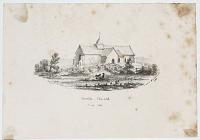
Hordle Church South Side.
M.A.T.W. [Mary Anne Theresa Whitby] Litho. Newlands 1830.
Rare lithograph. Printed area 110 x 180mm (4¼ x 7"), with wide margins. Foxing, mostly to edges.
The ancient church at Hordle, Hampshire around the time the old church was demolished in 1830. As the enclosure of previously common ground led to the town's population moving further north, the old church was demolished and a new one built closer to the new population centre The printmaker, Mary Anne Theresa Whitby (1784-1850), was married to Captain John Whitby, flag captain for Admiral Sir William Cornwallis. They lived on the admiral's estate, Newlands: after John's death in 1806, Mary stayed on, spending much of her time with Cornwallis, who left his estate to her on his death in 1819. Being a keen amateur lithographer, Whitby established a private press at Newlands, but she is better remembered for the first successful sericulture (silk production) to England after three centuries of attempts, presenting twenty yards of damask to Queen Victoria in 1844. She performed genetic experiments on her silkworms for Charles Darwin, who published her results in his 'The Variation of Animals and Plants Under Domestication' (1868). Ex: Collection of the late Hon. C. Lennox-Boyd.
[Ref: 35697] £65.00
(£78.00 incl.VAT)
![From the Book-room at the Villetta [two different versions of same view, with double portrait of Henri IV and Maria de Medicis]](img-thumbnail/jpegs/35680.jpg)
From the Book-room at the Villetta [two different versions of same view, with double portrait of Henri IV and Maria de Medicis]
M.A.T. Whitby . 1826.
Two transfer lithographs and one etching, lithograph sheets approx 115 x 180mm (4½ x 7"), etching 65 x 50mm (2½ x 2"). Each glued to backing sheet. Portrait trimmed to image in oval shape.
Two views near Milford on Sea, Hampshire, looking towards the needles, taken from Newlands, the estate the naval officer Sir William Cornwallis bought in 1799. The printmaker, Mary Anne Theresa Whitby (1784-1850), was married to Captain John Whitby, flag captain for Admiral Sir William Cornwallis. They lived on the admiral's estate, Newlands: after John's death in 1806, Mary stayed on, spending much of her time with Cornwallis, who left his estate to her on his death in 1819. Being a keen amateur lithographer, Whitby established a private press at Newlands, but she is better remembered for the first successful sericulture (silk production) to England after three centuries of attempts, presenting twenty yards of damask to Queen Victoria in 1844. She performed genetic experiments on her silkworms for Charles Darwin, who published her results in his 'The Variation of Animals and Plants Under Domestication' (1868). With a very late and worn double portrait of Henri IV and Msrie de Médicis by Simon van de Passe (etched c.1625, from a medal). For a London view by Whitby, see ref. 19290.
[Ref: 35680] £130.00
(£156.00 incl.VAT)
view all images for this item
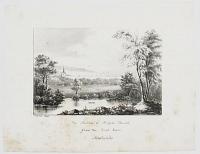
The Needles & Milford Church from the Oval Room. Newlands.
M.A.T.W. [Mary Anne Theresa Whitby] 1830.
Rare lithograph. Printed area 140 x 160mm (5½ x 6¼"), with wide margins. Foxing, mostly in title area.
View near Milford on Sea, Hampshire, looking towards the needles, taken from Newlands, the estate that the naval officer Sir William Cornwallis bought in 1799. The printmaker, Mary Anne Theresa Whitby (1784-1850), was married to Captain John Whitby, flag captain for Admiral Sir William Cornwallis. They lived on the admiral's estate, Newlands: after John's death in 1806, Mary stayed on, spending much of her time with Cornwallis, who left his estate to her on his death in 1819. Being a keen amateur lithographer, Whitby established a private press at Newlands, but she is better remembered for the first successful sericulture (silk production) to England after three centuries of attempts, presenting twenty yards of damask to Queen Victoria in 1844. She performed genetic experiments on her silkworms for Charles Darwin, who published her results in his 'The Variation of Animals and Plants Under Domestication' (1868). Ex: Collection of the late Hon. C. Lennox-Boyd; For a London view by Whitby, see ref. 19290.
[Ref: 35699] £130.00
(£156.00 incl.VAT)
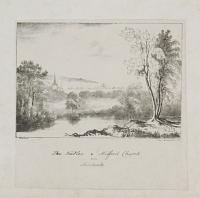
The Needles & Milford Church, from Newlands.
M.A.T.W. [Mary Anne Theresa Whitby] Litho. Newlands 1829.
Very rare lithograph on chine collé. 165 x 165mm (6½ x 6½").
View near Milford on Sea, Hampshire, looking towards the needles. Taken from the country seat of Newlands, which the naval officer Sir William Cornwallis bought in 1799. The printmaker, Mary Anne Theresa Whitby (1784-1850), was married to Captain John Whitby, flag captain for Admiral Sir William Cornwallis. They lived on the admiral's estate, Newlands: after John's death in 1806, Mary stayed on, spending much of her time with Cornwallis, who left his estate to her on his death in 1819. Being a keen amateur lithographer, Whitby established a private press at Newlands, but she is better remembered for the first successful sericulture (silk production) to England after three centuries of attempts, presenting twenty yards of damask to Queen Victoria in 1844. She performed genetic experiments on her silkworms for Charles Darwin, who published her results in his 'The Variation of Animals and Plants Under Domestication' (1868). For a London view by Whitby, see ref. 19290.
[Ref: 35679] £130.00
(£156.00 incl.VAT)
![Rufus's Stone / New Forest [ms]](img-thumbnail/jpegs/35714.jpg)
Rufus's Stone / New Forest [ms]
[Mary Anne Theresa Whitby] Litho. Newlands 1825.
Rare lithographPrinted area and title approx 205 x 310mm (8 x 12¼"), with wide margins. Foxing.
The Rufus Stone, marking the spot where King William II is believed to have been fatally wounded in 1100AD during a royal hunting visit in the New Forest (the king was nicknamed Rufus). The printmaker, Mary Anne Theresa Whitby (1784-1850), was married to Captain John Whitby, flag captain for Admiral Sir William Cornwallis. They lived on the admiral's estate, Newlands: after John's death in 1806, Mary stayed on, spending much of her time with Cornwallis, who left his estate to her on his death in 1819. Being a keen amateur lithographer, Whitby established a private press at Newlands, but she is better remembered for the first successful sericulture (silk production) to England after three centuries of attempts, presenting twenty yards of damask to Queen Victoria in 1844. She performed genetic experiments on her silkworms for Charles Darwin, who published her results in his 'The Variation of Animals and Plants Under Domestication' (1868). Ex: Collection of the late Hon. C. Lennox-Boyd.
[Ref: 35714] £90.00
(£108.00 incl.VAT)
![St. Effisius [Sardinia]](img-thumbnail/jpegs/35686.jpg)
St. Effisius [Sardinia]
M.A.T.W. [Mary Anne Theresa Whitby] Newlands Press [c.1828]
Lithograph, very rare with large margins; printed area 95 x 140mm (3¾ x 5¾").
Carriage for transporting a sculpture of St. Effisius, a Greek warrior who became a Christian and celebrated in Cagliari, Sardinia on May 1. In 1828 William Henry Smyth published his 'Sketch of the present state of the island of Sardinia' in which he wrote of the procession celebrating St Effisius: 'The gorgeous carriage then slowly advances; it consists principally of fine plate-glass, and containing the image of the Saint surrounded with lighted candles [...] I remarked to an acquaintance, that everybody appeared to be much attached to St. Effisius; "Ah!", said he, "it is with great reason; he saved our city from a dreadful plague,- he gave us rain when every other part of the island suffered from drought,- and he frustrated the designs of the French in 1793.' The printmaker, Mary Anne Theresa Whitby (1784-1850), was married to Captain John Whitby, flag captain for Admiral Sir William Cornwallis. They lived on the admiral's estate, Newlands: after John's death in 1806, Mary stayed on, spending much of her time with Cornwallis, who left his estate to her on his death in 1819. Being a keen amateur lithographer, Whitby established a private press at Newlands, but she is better remembered for the first successful sericulture (silk production) to England after three centuries of attempts, presenting twenty yards of damask to Queen Victoria in 1844. She performed genetic experiments on her silkworms for Charles Darwin, who published her results in his 'The Variation of Animals and Plants Under Domestication' (1868). Ex: Collection of the late Hon. C. Lennox-Boyd.
[Ref: 35686] £95.00
(£114.00 incl.VAT)
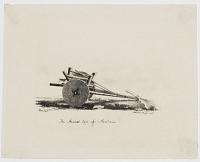
The Ancient Cart of Sardinia.
M.A.T.W. [Mary Anne Theresa Whitby] Newland Press 1827.
Rare lithograph. Printed area 120 x 180mm (4¾ x 7").
The printmaker, Mary Anne Theresa Whitby (1784-1850), was married to Captain John Whitby, flag captain for Admiral Sir William Cornwallis. They lived on the admiral's estate, Newlands: after John's death in 1806, Mary stayed on, spending much of her time with Cornwallis, who left his estate to her on his death in 1819. Being a keen amateur lithographer, Whitby established a private press at Newlands, but she is better remembered for the first successful sericulture (silk production) to England after three centuries of attempts, presenting twenty yards of damask to Queen Victoria in 1844. She performed genetic experiments on her silkworms for Charles Darwin, who published her results in his 'The Variation of Animals and Plants Under Domestication' (1868). Ex: Collection of the late Hon. C. Lennox-Boyd.
[Ref: 35688] £95.00
(£114.00 incl.VAT)
![[Donkey powering water wheel, Sardinia.]](img-thumbnail/jpegs/35690.jpg)
[Donkey powering water wheel, Sardinia.]
[probably lithographed by Mary Anne Theresa Whitby c.1828.]
Rare lithograph. Printed area 120 x 170mm (4¾ x 6¾")
Donkey turning an axle to power a water wheel, observed by a friar. The printmaker, Mary Anne Theresa Whitby (1784-1850), was married to Captain John Whitby, flag captain for Admiral Sir William Cornwallis. They lived on the admiral's estate, Newlands: after John's death in 1806, Mary stayed on, spending much of her time with Cornwallis, who left his estate to her on his death in 1819. Being a keen amateur lithographer, Whitby established a private press at Newlands, but she is better remembered for the first successful sericulture (silk production) to England after three centuries of attempts, presenting twenty yards of damask to Queen Victoria in 1844. She performed genetic experiments on her silkworms for Charles Darwin, who published her results in his 'The Variation of Animals and Plants Under Domestication' (1868). Ex: Collection of the late Hon. C. Lennox-Boyd.
[Ref: 35690] £120.00
(£144.00 incl.VAT)
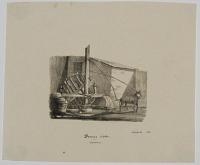
Drawing Water. Sardinia.
[by Mary Anne Theresa Whitby] Newlands, 1828
Rare lithograph. Printed area 130 x 135mm (5 x 5¼")
A donkey turning an axle to power a water wheel. The printmaker, Mary Anne Theresa Whitby (1784-1850), was married to Captain John Whitby, flag captain for Admiral Sir William Cornwallis. They lived on the admiral's estate, Newlands: after John's death in 1806, Mary stayed on, spending much of her time with Cornwallis, who left his estate to her on his death in 1819. Being a keen amateur lithographer, Whitby established a private press at Newlands, but she is better remembered for the first successful sericulture (silk production) to England after three centuries of attempts, presenting twenty yards of damask to Queen Victoria in 1844. She performed genetic experiments on her silkworms for Charles Darwin, who published her results in his 'The Variation of Animals and Plants Under Domestication' (1868). Ex: Collection of the late Hon. C. Lennox-Boyd.
[Ref: 35691] £120.00
(£144.00 incl.VAT)

Point Colonna, Isle of St. Pietro
[Probably by Mary Anne Theresa Whitby, c.1828]
Rare lithograph, printed on chine collé. 145 x 210mm (5¾ x 8¼"), with wide margins. Foxing.
View of the distinctive rock formation of Punta Colonna on the island of San Pietro off the west coast of Sardinia. The printmaker, Mary Anne Theresa Whitby (1784-1850), was married to Captain John Whitby, flag captain for Admiral Sir William Cornwallis. They lived on the admiral's estate, Newlands: after John's death in 1806, Mary stayed on, spending much of her time with Cornwallis, who left his estate to her on his death in 1819. Being a keen amateur lithographer, Whitby established a private press at Newlands, but she is better remembered for the first successful sericulture (silk production) to England after three centuries of attempts, presenting twenty yards of damask to Queen Victoria in 1844. She performed genetic experiments on her silkworms for Charles Darwin, who published her results in his 'The Variation of Animals and Plants Under Domestication' (1868). Ex: Collection of the late Hon. C. Lennox-Boyd.
[Ref: 35712] £180.00
(£216.00 incl.VAT)
![The Cart according to the recent Proclamation [Sardinia]](img-thumbnail/jpegs/35694.jpg)
The Cart according to the recent Proclamation [Sardinia]
M.A.T.W. [Mary Anne Theresa Whitby] Newland Press [c.1828]
Rare lithograph, printed area 110 x 190mm (4¼ x 7½").
The printmaker, Mary Anne Theresa Whitby (1784-1850), was married to Captain John Whitby, flag captain for Admiral Sir William Cornwallis. They lived on the admiral's estate, Newlands: after John's death in 1806, Mary stayed on, spending much of her time with Cornwallis, who left his estate to her on his death in 1819. Being a keen amateur lithographer, Whitby established a private press at Newlands, but she is better remembered for the first successful sericulture (silk production) to England after three centuries of attempts, presenting twenty yards of damask to Queen Victoria in 1844. She performed genetic experiments on her silkworms for Charles Darwin, who published her results in his 'The Variation of Animals and Plants Under Domestication' (1868). Ex: Collection of the late Hon. C. Lennox-Boyd.
[Ref: 35694] £95.00
(£114.00 incl.VAT)
![The Barge of the Adventure saving the Crew of a Bombard [ms].](img-thumbnail/jpegs/37544.jpg)
The Barge of the Adventure saving the Crew of a Bombard [ms].
M.A.J. Whitby. Newlands 1828.
Rare lithograph, printed area and text 130 x 170mm (5 x 6¾").
This print probably shows the crew of the HMS Adventure coming to the aid of shipwrecked sailors, perhaps off the coast of North Africa. The printmaker, Mary Anne Theresa Whitby (1784-1850) appears to have spent time in Italy and North Africa in the 1820s or before, and the Adventure was in Leptis Magna, near Tripoli in modern-day Libya, in 1817. Whitby was married to Captain John Whitby, flag captain for Admiral Sir William Cornwallis. They lived on the admiral's estate, Newlands: after John's death in 1806, Mary stayed on, spending much of her time with Cornwallis, who left his estate to her on his death in 1819. Being a keen amateur lithographer, Whitby established a private press at Newlands, but she is better remembered for the first successful sericulture (silk production) to England after three centuries of attempts, presenting twenty yards of damask to Queen Victoria in 1844. She performed genetic experiments on her silkworms for Charles Darwin, who published her results in his 'The Variation of Animals and Plants Under Domestication' (1868). Ex Collection of the Late Hon. C. Lennox-Boyd; for Whitby, see refs. 35710, 35711 etc
[Ref: 37544] £180.00
(£216.00 incl.VAT)
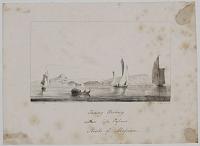
Tunny Fishery with Cape Passero. Straits of Messina
M.A.T.W. [Mary Anne Theresa Whitby] 1822. Litho. Newlands 1830
Rare lithograph. Printed area 150 x 180mm (6 x 7"), with wide margins. Foxing.
Tuna fishing in the Strait of Messina, which separates mainland Italy from Sicily. The printmaker, Mary Anne Theresa Whitby (1784-1850), was married to Captain John Whitby, flag captain for Admiral Sir William Cornwallis. They lived on the admiral's estate, Newlands: after John's death in 1806, Mary stayed on, spending much of her time with Cornwallis, who left his estate to her on his death in 1819. Being a keen amateur lithographer, Whitby established a private press at Newlands, but she is better remembered for the first successful sericulture (silk production) to England after three centuries of attempts, presenting twenty yards of damask to Queen Victoria in 1844. She performed genetic experiments on her silkworms for Charles Darwin, who published her results in his 'The Variation of Animals and Plants Under Domestication' (1868). Ex: Collection of the late Hon. C. Lennox-Boyd.
[Ref: 35700] £160.00
(£192.00 incl.VAT)
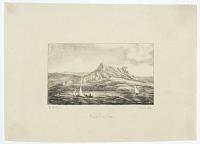
Punta dell'Ursa.
M.A.T.W. [Mary Anne Theresa Whitby] Newlands [c.1828].
Rare lithograph. Printed area 105 x 140mm (4 x 5½").
The printmaker, Mary Anne Theresa Whitby (1784-1850), was married to Captain John Whitby, flag captain for Admiral Sir William Cornwallis. They lived on the admiral's estate, Newlands: after John's death in 1806, Mary stayed on, spending much of her time with Cornwallis, who left his estate to her on his death in 1819. Being a keen amateur lithographer, Whitby established a private press at Newlands, but she is better remembered for the first successful sericulture (silk production) to England after three centuries of attempts, presenting twenty yards of damask to Queen Victoria in 1844. She performed genetic experiments on her silkworms for Charles Darwin, who published her results in his 'The Variation of Animals and Plants Under Domestication' (1868). Ex: Collection of the late Hon. C. Lennox-Boyd.
[Ref: 35693] £160.00
(£192.00 incl.VAT)
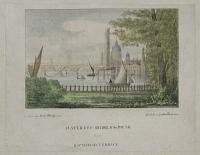
Waterloo Bridge & St Pauls from Richmond Terrace.
On Stone by M.A.J. Whitby. 1858. Sketched by Adm.l Sartorius.
Rare lithograph, printed on chine collé, with hand colour. 180 x 230mm (7 x 9").
An amateur view of the Waterloo Bridge, St Paul's Cathedral and the Shot Tower, by Admiral George Sartorius (1790-1883), who had witnessed the surrender of Napoleon Bonaparte aboard the Bellerophon at Rochefort. The printmaker, Mary Anne Theresa Whitby (1784-1850), was married to Captain John Whitby, flag captain for Admiral Sir William Cornwallis. They lived on the admiral's estate, Newlands: after John's death in 1806, Mary stayed on, spending much of her time with Cornwallis, who left his estate to her on his death in 1819. Being a keen amateur lithographer, Whitby established a private press at Newlands, but she is better remembered for the first successful sericulture (silk production) to England after three centuries of attempts, presenting twenty yards of damask to Queen Victoria in 1844. She performed genetic experiments on her silkworms for Charles Darwin, who published her results in his 'The Variation of Animals and Plants Under Domestication' (1868).
[Ref: 19290] £160.00
(£192.00 incl.VAT)
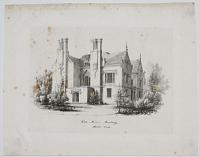
West Meon Rectory. North Front.
M.A.T.W. [Mary Anne Theresa Whitby] 1830.
Rare lithograph on chine collé. 185 x 245mm (7¼ x 9½"), with wide margins.
The Tudor and Jacobean rectory in West Meon, Hampshire (now a private residence). At the time this print was made, it was occupied by clergyman Henry Vincent Bayley (1777-1844) who had earlier played an important role in the renovation of Lincoln Cathedral. The printmaker, Mary Anne Theresa Whitby (1784-1850), was married to Captain John Whitby, flag captain for Admiral Sir William Cornwallis. They lived on the admiral's estate, Newlands: after John's death in 1806, Mary stayed on, spending much of her time with Cornwallis, who left his estate to her on his death in 1819. Being a keen amateur lithographer, Whitby established a private press at Newlands, but she is better remembered for the first successful sericulture (silk production) to England after three centuries of attempts, presenting twenty yards of damask to Queen Victoria in 1844. She performed genetic experiments on her silkworms for Charles Darwin, who published her results in his 'The Variation of Animals and Plants Under Domestication' (1868). Ex: Collection of the late Hon. C. Lennox-Boyd; For a London view by Whitby, see ref. 19290.
[Ref: 35702] £130.00
(£156.00 incl.VAT)

West Meon Rectory. West Front.
M.A.T.W. [Mary Anne Theresa Whitby]1830
Rare lithograph, printed on chine collé. 145 x 190mm (5¼ x 7½"), with wide margins.
The Tudor and Jacobean rectory in West Meon, Hampshire (now a private residence). At the time this print was made, it was occupied by clergyman Henry Vincent Bayley (1777-1844) who had earlier played an important role in the renovation of Lincoln Cathedral. The printmaker, Mary Anne Theresa Whitby (1784-1850), was married to Captain John Whitby, flag captain for Admiral Sir William Cornwallis. They lived on the admiral's estate, Newlands: after John's death in 1806, Mary stayed on, spending much of her time with Cornwallis, who left his estate to her on his death in 1819. Being a keen amateur lithographer, Whitby established a private press at Newlands, but she is better remembered for the first successful sericulture (silk production) to England after three centuries of attempts, presenting twenty yards of damask to Queen Victoria in 1844. She performed genetic experiments on her silkworms for Charles Darwin, who published her results in his 'The Variation of Animals and Plants Under Domestication' (1868). Ex: Collection of the late Hon. C. Lennox-Boyd; For a London view by Whitby, see ref. 19290.
[Ref: 35703] £75.00
(£90.00 incl.VAT)
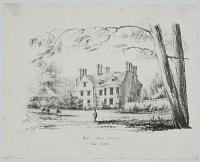
West Meon Rectory East Front.
[Mary Anne Theresa Whitby, c.1830.]
Rare lithograph. Printed area 185 x 255mm (7¼ x 10"), with wide margins. Foxing.
The Tudor and Jacobean rectory in West Meon, Hampshire (now a private residence). At the time this print was made, it was occupied by clergyman Henry Vincent Bayley (1777-1844) who had earlier played an important role in the renovation of Lincoln Cathedral. The printmaker, Mary Anne Theresa Whitby (1784-1850), was married to Captain John Whitby, flag captain for Admiral Sir William Cornwallis. They lived on the admiral's estate, Newlands: after John's death in 1806, Mary stayed on, spending much of her time with Cornwallis, who left his estate to her on his death in 1819. Being a keen amateur lithographer, Whitby established a private press at Newlands, but she is better remembered for the first successful sericulture (silk production) to England after three centuries of attempts, presenting twenty yards of damask to Queen Victoria in 1844. She performed genetic experiments on her silkworms for Charles Darwin, who published her results in his 'The Variation of Animals and Plants Under Domestication' (1868). Ex: Collection of the late Hon. C. Lennox-Boyd; For a London view by Whitby, see ref. 19290.
[Ref: 35704] £75.00
(£90.00 incl.VAT)
![[Figure next to a structure.]](img-thumbnail/jpegs/35682.jpg)
[Figure next to a structure.]
[Probably by Mary Anne Theresa Whitby, c.1820s]
Rare lithograph. 95 x 135mm (3¾ x 5¼).
Scene, probably inspired by travels in Sardinia by Mary Anne Theresa Whitby (1784-1850). The printmaker, Mary Anne Theresa Whitby (1784-1850), was married to Captain John Whitby, flag captain for Admiral Sir William Cornwallis. They lived on the admiral's estate, Newlands: after John's death in 1806, Mary stayed on, spending much of her time with Cornwallis, who left his estate to her on his death in 1819. Being a keen amateur lithographer, Whitby established a private press at Newlands, but she is better remembered for the first successful sericulture (silk production) to England after three centuries of attempts, presenting twenty yards of damask to Queen Victoria in 1844. She performed genetic experiments on her silkworms for Charles Darwin, who published her results in his 'The Variation of Animals and Plants Under Domestication' (1868). Ex: Collection of the late Hon. C. Lennox-Boyd; for a London view by Whitby, see ref. 19290.
[Ref: 35682] £65.00
(£78.00 incl.VAT)
<<< Previous 1 Next >>>



![From the Book-room at the Villetta [two different versions of same view, with double portrait of Henri IV and Maria de Medicis]](img-thumbnail/jpegs/35680.jpg)


![Rufus's Stone / New Forest [ms]](img-thumbnail/jpegs/35714.jpg)
![St. Effisius [Sardinia]](img-thumbnail/jpegs/35686.jpg)

![[Donkey powering water wheel, Sardinia.]](img-thumbnail/jpegs/35690.jpg)


![The Cart according to the recent Proclamation [Sardinia]](img-thumbnail/jpegs/35694.jpg)
![The Barge of the Adventure saving the Crew of a Bombard [ms].](img-thumbnail/jpegs/37544.jpg)






![[Figure next to a structure.]](img-thumbnail/jpegs/35682.jpg)